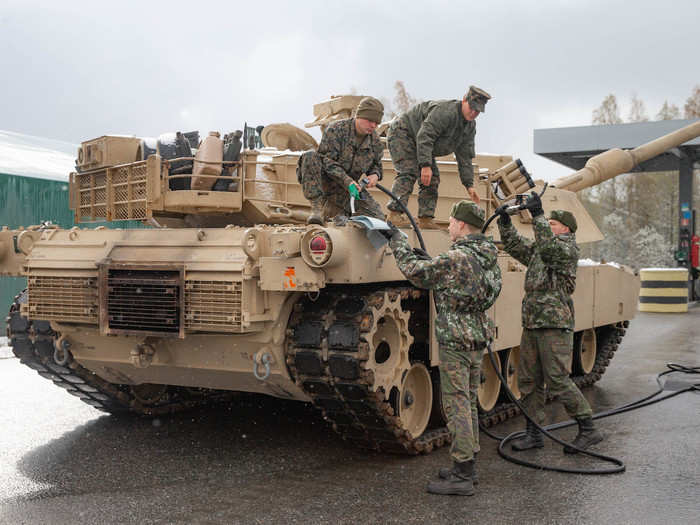

![While there was just one Marine M1A1 Abrams tank platoon last year, "this year's exercise involved an M1A1 Abrams tank platoon, a Light Armored Vehicle platoon, High-Mobility Multipurpose Wheeled Vehicles (Humvees), [and] Medium Tactical Vehicle Replacement 7-ton trucks," Rankine-Galloway said. While there was just one Marine M1A1 Abrams tank platoon last year, "this year's exercise involved an M1A1 Abrams tank platoon, a Light Armored Vehicle platoon, High-Mobility Multipurpose Wheeled Vehicles (Humvees), [and] Medium Tactical Vehicle Replacement 7-ton trucks," Rankine-Galloway said.](/thumb/msid-60085318,width-700,height-525/60085318.jpg)


![The exercise consisted "of a force-on-force portion where Outlaw Troop was attached to a Finnish Battalion as they conducted [situational training exercise] maneuvers against another Finnish battalion," Capt. Jimmyn Lee, Outlaw Troop commander, said in a release. The exercise consisted "of a force-on-force portion where Outlaw Troop was attached to a Finnish Battalion as they conducted [situational training exercise] maneuvers against another Finnish battalion," Capt. Jimmyn Lee, Outlaw Troop commander, said in a release.](/thumb/msid-60085318,width-700,height-525/60085318.jpg)



![DISE provides video-game-like playback, with fast-forwarding and rewinding. "With MILES, you get the adjudication of kills and just the basic level of force-on-force support," Lee said. "However, with DISE, the [after-action review] capability was the biggest gain." DISE provides video-game-like playback, with fast-forwarding and rewinding. "With MILES, you get the adjudication of kills and just the basic level of force-on-force support," Lee said. "However, with DISE, the [after-action review] capability was the biggest gain."](/thumb/msid-60085318,width-700,height-525/60085318.jpg)
With DISE, US personnel could also simulate injuries, allowing for scenarios in which soldiers could perform combat lifesaver measures to reset the vests and to add more time to soldiers' virtual lives.


![The disparity in tactics and procedures requires US troops to get in contact with Finnish leadership, Lee said, "to ensure that they understand how we fight [and] how they best could employ us if we are attached to them." The disparity in tactics and procedures requires US troops to get in contact with Finnish leadership, Lee said, "to ensure that they understand how we fight [and] how they best could employ us if we are attached to them."](/thumb/msid-60085318,width-700,height-525/60085318.jpg)

!["The biggest thing is understanding the capabilities of your other counterparts and allies, seeing the strengths that they have," Brunnemer said. "Understanding how they can complement ourselves [is necessary] so that [we] are able to accomplish the mission." "The biggest thing is understanding the capabilities of your other counterparts and allies, seeing the strengths that they have," Brunnemer said. "Understanding how they can complement ourselves [is necessary] so that [we] are able to accomplish the mission."](/thumb/msid-60085318,width-700,height-525/60085318.jpg)

!["They've been a very interesting enemy to fight for us because they're in their [Light Armored Vehicles], kind of an analogous to our [Dragoon Infantry Carrier Vehicle], and they had a platoon of Abrams," Lee said of the Marines. "They proved to be a challenging enemy to have to plan against and maneuver against, but I'd say our guys did very well against them." "They've been a very interesting enemy to fight for us because they're in their [Light Armored Vehicles], kind of an analogous to our [Dragoon Infantry Carrier Vehicle], and they had a platoon of Abrams," Lee said of the Marines. "They proved to be a challenging enemy to have to plan against and maneuver against, but I'd say our guys did very well against them."](/thumb/msid-60085318,width-700,height-525/60085318.jpg)





 Colon cancer rates are rising in young people. If you have two symptoms you should get a colonoscopy, a GI oncologist says.
Colon cancer rates are rising in young people. If you have two symptoms you should get a colonoscopy, a GI oncologist says. I spent $2,000 for 7 nights in a 179-square-foot room on one of the world's largest cruise ships. Take a look inside my cabin.
I spent $2,000 for 7 nights in a 179-square-foot room on one of the world's largest cruise ships. Take a look inside my cabin. An Ambani disruption in OTT: At just ₹1 per day, you can now enjoy ad-free content on JioCinema
An Ambani disruption in OTT: At just ₹1 per day, you can now enjoy ad-free content on JioCinema Reliance gets thumbs-up from S&P, Fitch as strong earnings keep leverage in check
Reliance gets thumbs-up from S&P, Fitch as strong earnings keep leverage in check
 Realme C65 5G with 5,000mAh battery, 120Hz display launched starting at ₹10,499
Realme C65 5G with 5,000mAh battery, 120Hz display launched starting at ₹10,499
 8 Fun things to do in Kasol
8 Fun things to do in Kasol

Copyright © 2024. Times Internet Limited. All rights reserved.For reprint rights. Times Syndication Service.